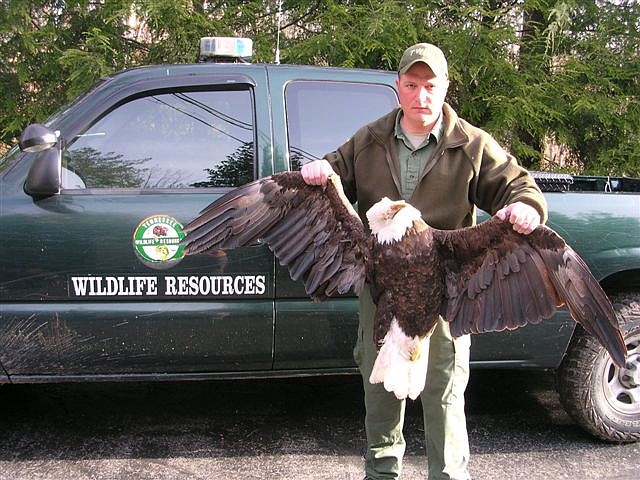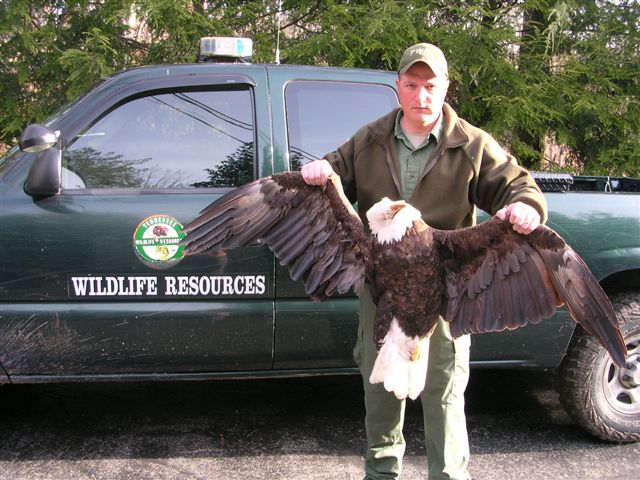Wildlife officials seek leads in eagle slayings
Wednesday, April 13, 2011
REWARD FOR INFORMATIONA $17,000 reward is offered by the Tennessee Wildlife Resources Agency for any information about the eagle shootings that leads to a conviction.* Cumberland County: Anyone with information about the Cumberland County eagle shooting can call TWRA special agent John Rayfield at 615-736-5532 or Cumberland County Wildlife Officer Casey Mullen at 800-262-6704.* Bledsoe County: Anyone with information about the Bledsoe County eagle shooting can call special agent Bo Stone at 865-692-4024 or Bledsoe County Wildlife Officer Mark Patterson at 800-262-6704.BALD EAGLE FACTS* The Continental Congress declared the bald eagle our national symbol on June 20, 1782. Benjamin Franklin preferred the turkey.* Bald eagles live 20 to 35 years in the wild and as long as 50 years in captivity.* Adult males weigh up to 9 pounds and females weigh between 12 and 13 pounds.* They develop their distinctive white heads and tails when they are between 4 and 5 years old.* They mate for life, but may take another mate if their first mate dies.* Eagles' diets are 70 percent to 90 percent fish.* Their wingspread is 6 to 8 feet.* Horizontal flight speed has been measured at up to 44 mph.Source: Tennessee Wildlife Resources Agency
Leads and information are trickling in, but wildlife officials say they still need the public to help identify the killer or killers of two bald eagles in Bledsoe and Cumberland counties.
A $17,000 reward is available for information leading to convictions in the February slayings.
Tennessee Wildlife Resources Agency spokesman Dan Hicks said investigators are tracking down some leads and seeking new information in the shootings of an American bald eagle in Bledsoe County and another in Cumberland County, about 30 miles away.
"We've had a number of calls," Hicks said. He described some of the calls as "weird," while he said others provided some helpful information if not direct leads.
Some people called to express their anger.
"I've gotten some calls from people who say they want to string [the shooter] up," he said.
Al Louis Cecere, president of the American Eagle Foundation in Pigeon Forge, Tenn., was at a loss to explain why the bald eagle is the target of illegal hunting.
"It's very disheartening that people in this day and age are still shooting bald eagles, our national bird," Cecere said. "That shows that there is still a lot of education that needs to happen to let people know that the bald eagle is a protected species."
Bald eagles primarily eat fish and other aquatic animals such as coots, water fowl, muskrats and the like, he said.
"But there's absolutely no reason why anyone should be shooting a bald eagle," Cecere said. "Even though they've been removed from the endangered species list, they still have very strict protection."
The Bald and Golden Eagle Protection Act and Migratory Bird Treaty Act carry maximum criminal penalties of up to $100,000 and/or a year in prison for killing a bald eagle, according to wildlife officials.
The two eagles shot in February in Tennessee account for two of the three birds shot in the past year, Cecere said.
An eagle injured by a shotgun blast a year ago in Cumberland County was treated at the foundation facility in Pigeon Forge, he said.
"It was shot up pretty good," he said. "It had BBs throughout its body. The right wing was where the most damage was caused."
Even though foundation officials thought that eagle never would fly again, it managed to recover, Cecere said.
"It was released in December 2010," he said.

